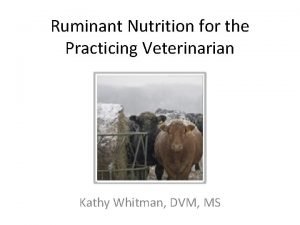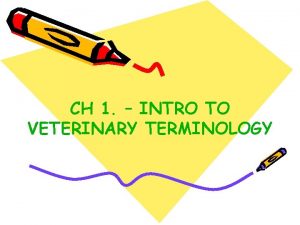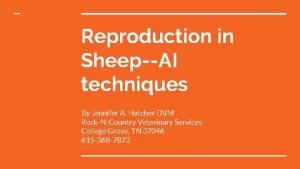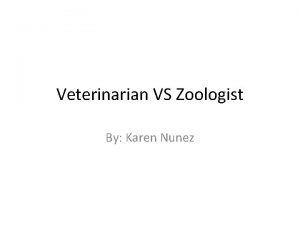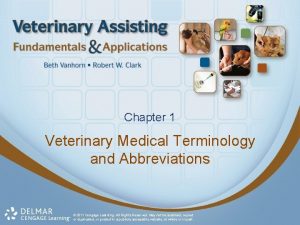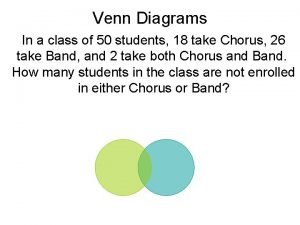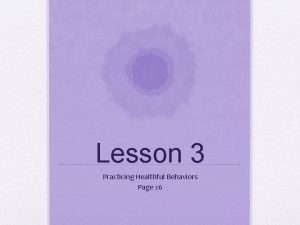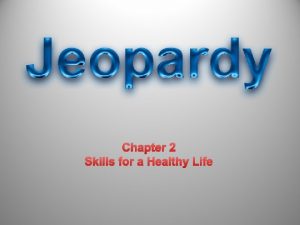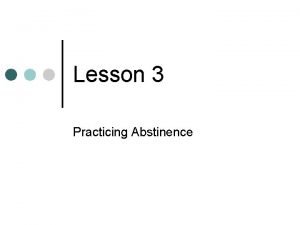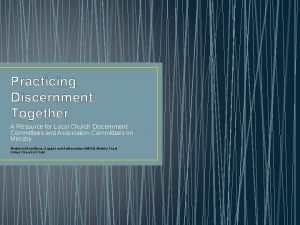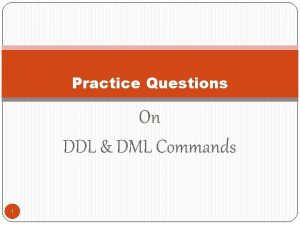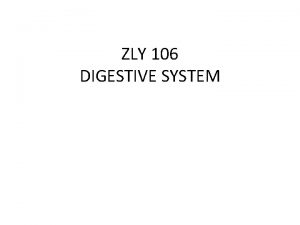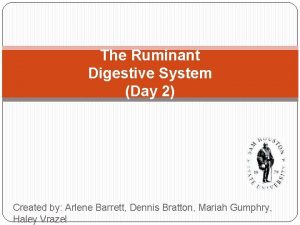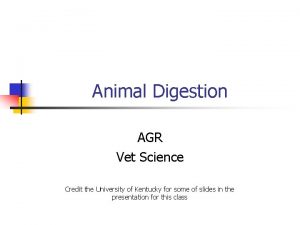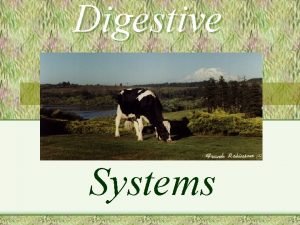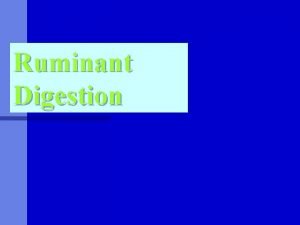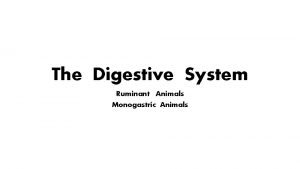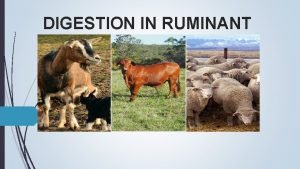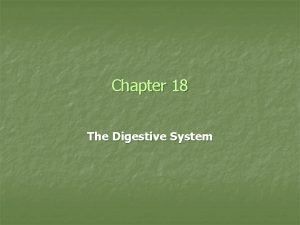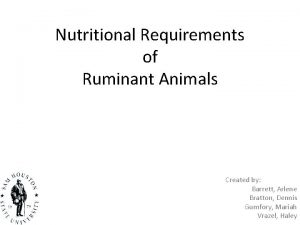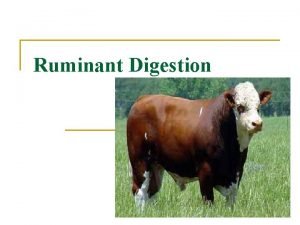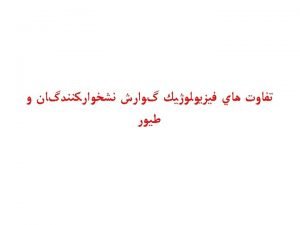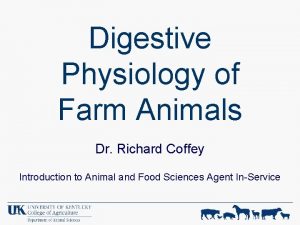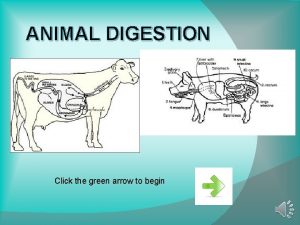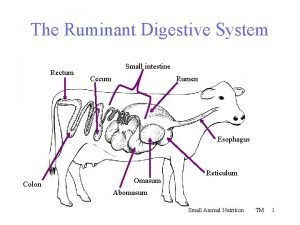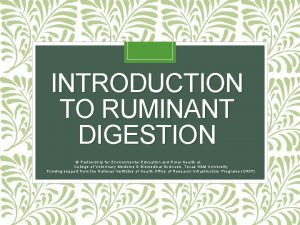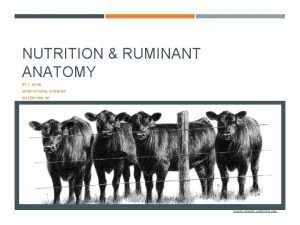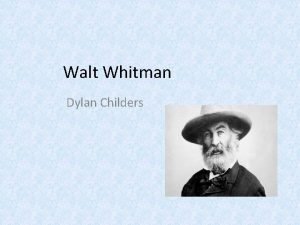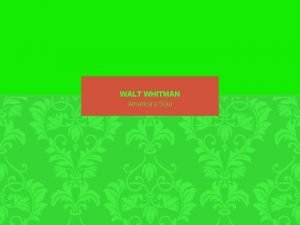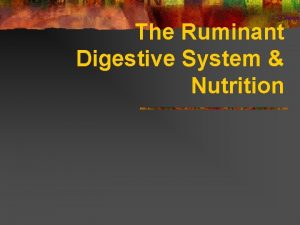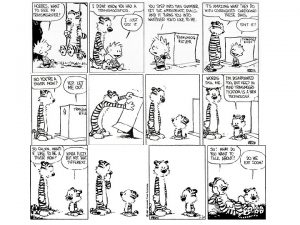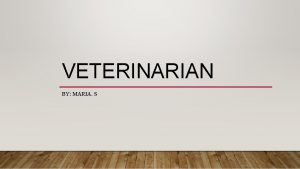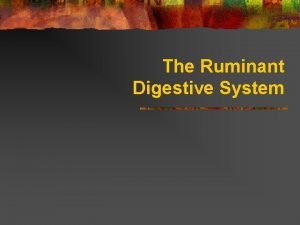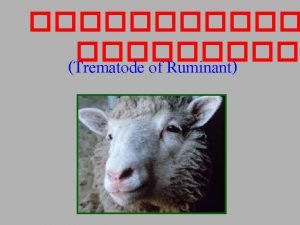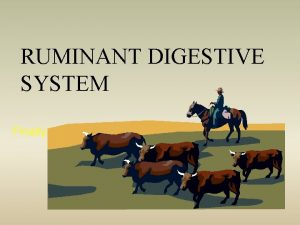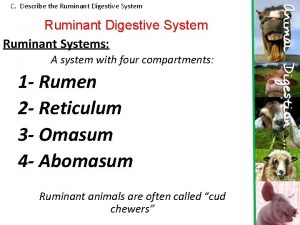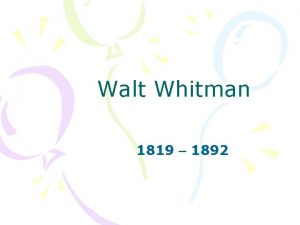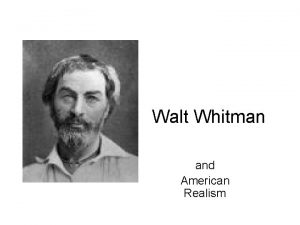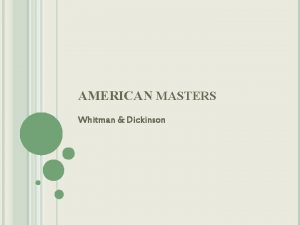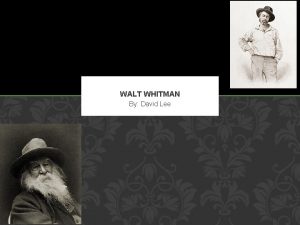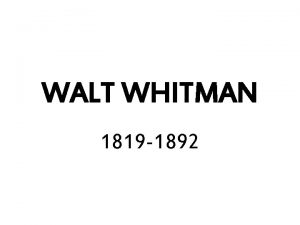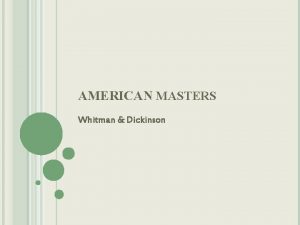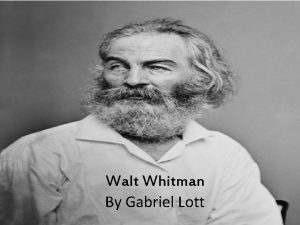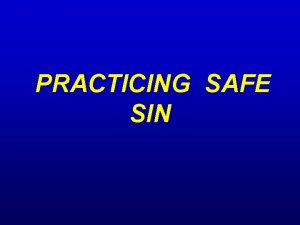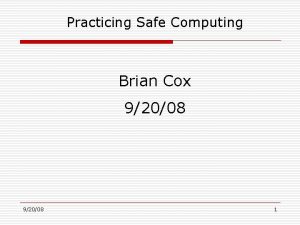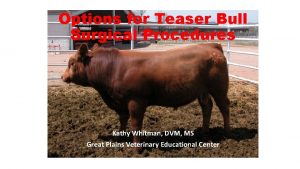Ruminant Nutrition for the Practicing Veterinarian Kathy Whitman



































- Slides: 35

Ruminant Nutrition for the Practicing Veterinarian Kathy Whitman, DVM, MS

Nutrition: All processes in the collection and utilization of feedstuffs for maintaining life or production of a product. Involves behavior, digestions, absorption, metabolism, and excretion.

Question 1 • What percentage of beef cow production cost is related to nutrition? A. B. C. D. 15% 25% 50% 65%

Nutrient Requirements • • • Water Protein Carbohydrates Fats Vitamins Minerals http: //www. nap. edu/read/19014/chapter/1

Nutrition Acronyms • • DMI AFB NDF/ADF CP, DIP, UIP TDN NEm, NEg, Nel VFAs DOF

Question 2 • When reading a feed label, what is “ash? ” A. The amount of fine particles after sifting B. The mineral content C. The vitamin content D. The dry matter percentage

Reading a feed label www. aafco. org

Reading Feed Analysis Near Infrared Reflectance Spectroscopy (NIRS) Analysis As Fed 100% Dry Matter Moisture, % 7. 3 Dry Matter, % 92. 7 Crude Protein, % CP 19. 5 21. 0 Acid Detergent Fiber, % ADF 26. 6 28. 7 Neutral Detergent Fiber, % NDF 35. 4 38. 2 Total Digestible Nutrients, % TDN 65. 3 70. 4 Net Energy, Maint, Mcal/lb 0. 70 0. 75 Net Energy, Gain, Mcal/lb 0. 44 0. 47 Net Energy, Lact, Mcal/lb 0. 68 0. 73 Digestible Energy, Mcal/lb 1. 31 1. 41 Met. Energy, Beef, Mcal/lb 1. 07 1. 16 Relative Feed Value, (RFV) 162 Calcium, % Ca 1. 18 1. 28 Phosphorus, % P 0. 27 0. 29 Magnesium, % Mg 0. 25 0. 27 Potassium, % K 2. 93 3. 16

What is a ruminant? • Fermentation! – Ruminants digest 50 -70% cellulose; monogastrics 3 -5% • Feeding bugs

Question 3 • How many stomach compartments does a camelid have? A. 2 B. 3 C. 4 D. 5

Important Species Differences • Cu in sheep vs. other ruminant species • Monensin (Rumensin) max dose: 360 vs 40 mg/hd/day

What determines requirements? • • • Age? Stage of production? Body condition? Environment? Feedstuffs available? Producer goals?

Changes in requirement

What is the Focus? • Major balancers – Protein: 8% Cows, 13 -14% Heifers (MINIMUMS!!) – Energy: TDN, NEm, NEg, NEl – Ca: P ratio-what is appropriate? • Adjustments – Supplementation? ?

Rules of thumb • Water intake: 8 -16% BW • Feed intake (Dry Matter): 1. 5 -2. 2% BW • Nutrient requirements – Protein: 0. 15 -0. 2% BW – Energy (TDN): 1 -1. 8% BW – Ca: P: 2 -3: 1 Ratio, 0. 2 -0. 3%: 0. 1 -0. 15% BW

Feed sources • Forage • Concentrates

Question In the traditional spring calving cattle cycle, how much time does a bovine that will be fed for human consumption spend on pasture? A. Never, it goes right to a feedlot B. Allowed to graze until weaned at 2 months, then confined and put on a grain diet C. Allowed to graze until weaned at 6 months, then confined and put on a grain diet D. It grazes until right before harvest with no confinement

Pasture Management Lactation Grazing Supplement?

Confined feeding • “Dry lot” • Less available land space • Advantages? • Disadvantages? http: //beef. unl. edu/cattleproduction/drylotting beefcows

Protein • Function • Ruminant metabolism – AA contruction – Fiber utilization – Why is it unnecessary to supplement daily? • General requirements – 0. 15 -0. 2% BW

Question 5 • In general, there are 10 essential amino acids. What additional amino acid is required by cats? A. Taurine B. Leucine C. Methionine D. Tryptophan

Energy • How do we measure energy in rations? – TDN – NE – NDF/ADF – Non-structural: Starches/sugars • Where do ruminants derive energy? – VFAs – Non-structural carbs

Question 4 True or False? The energy demand of a cow at maintenance is higher when the temperature is 80 F vs. 20 F Thermo-neutral Zone: 32 -77 F

Vitamins and Minerals

Vitamins and Minerals

Feed Additives • Nutrient supplementation – Salt block – Lick tubs – Fly controls • Ionophores – Monensin • Antibiotics – CTC – Tylan • Hormones – MGA

Veterinary Feed Directives • Prohibits use of antimicrobials for production • Affects feed grade antimicrobials – Not water or parenteral • ELDU not applicable • Prescription required • Limits availability, esp. for small ruminants

Question True or False? Ionophores are considered antibiotics

Nutritional Disease • Deficiencies • Toxicities • Interactions

Obvious…

…Sub-clinical

How do we know? • Tools to evaluate nutritional status – Body Condition Scoring • https: //beef. unl. edu/learning/condition 1 a. shtml – Behavior? • Health issues – Increases is morbidity or mortality – Unthrifty – Ineffective preventatives, treatments • Performance issues – Reproductive deficiencies – Poor growth

Diagnostics • Body condition scoring – https: //beef. unl. edu/learning/condition 1 a. shtml • Feed analysis • Rumen contents – p. H – Microbial activity • Blood analysis – Acute disease – Validity for deficiencies/toxicities? – NEFAs, ketones (BHB is best) • Tissue analysis – Liver biopsy: https: //youtu. be/3 Zhezywr. N 8 U – Fetal tissues

Nutrition Resources Feed analysis: https: //youtu. be/t 4 sg. XS 8 H 53 k

A Word on Different Ruminants… • Cattle – Cow-calf – Feedlot – Dairy • Sheep/Goats – Pasture – Feedlot
 Kathy whitman
Kathy whitman Veterinarian pronounciation
Veterinarian pronounciation Castration meaning
Castration meaning Jennifer hatcher vet
Jennifer hatcher vet Veterinarian vs zoologist
Veterinarian vs zoologist Veterinarian suffix
Veterinarian suffix A veterinarian surveys 26 of his patrons
A veterinarian surveys 26 of his patrons Good life poem
Good life poem Practicing healthful behaviors
Practicing healthful behaviors Chapter 2 skills and applications
Chapter 2 skills and applications Chapter 8 lesson 3 practicing abstinence
Chapter 8 lesson 3 practicing abstinence Stage 27 practicing the language answers
Stage 27 practicing the language answers Practicing design
Practicing design Practicing discernment
Practicing discernment Dml commands
Dml commands Sheep digestive system
Sheep digestive system Ruminant digestive system
Ruminant digestive system Digestive system in poultry
Digestive system in poultry Ruminant animals
Ruminant animals Aude ferran
Aude ferran Ruminant animals
Ruminant animals 4 chambers of the ruminant stomach
4 chambers of the ruminant stomach Define todays
Define todays Ruminant animals
Ruminant animals Pancreatic juice
Pancreatic juice Nutritional requirements for ruminant animals
Nutritional requirements for ruminant animals What animal is this
What animal is this Cow digestive system
Cow digestive system Pprotozoa
Pprotozoa Pseudo ruminant examples
Pseudo ruminant examples Ruminant digestion
Ruminant digestion Cow digestive system diagram
Cow digestive system diagram 4 chambers of the ruminant stomach
4 chambers of the ruminant stomach Dylan whitman
Dylan whitman One's self i sing sparknotes
One's self i sing sparknotes Walt whitman happiness not in another place
Walt whitman happiness not in another place
